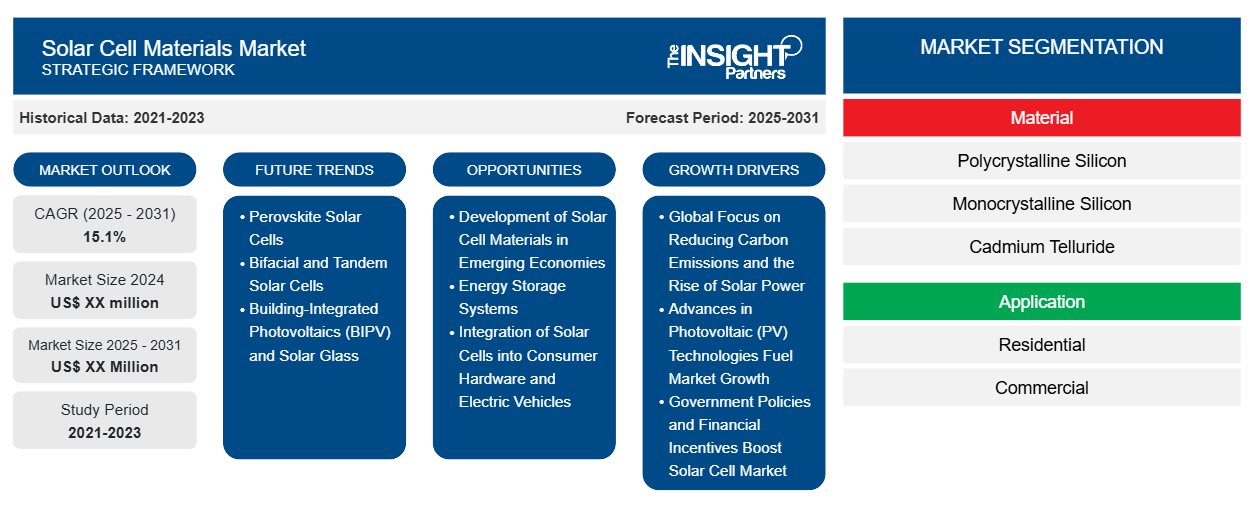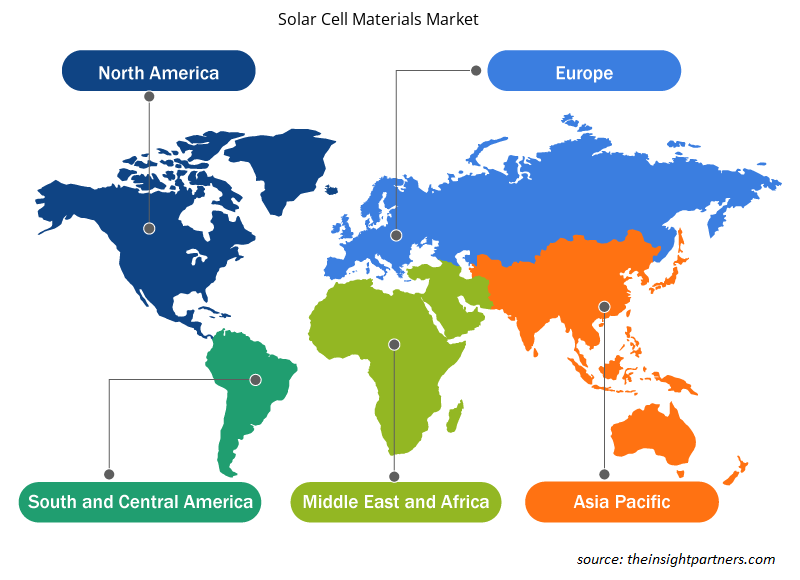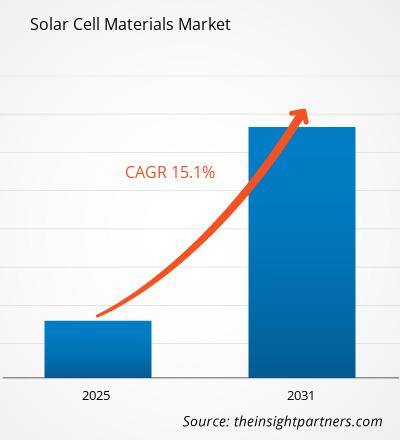The Solar Cell Materials Market is expected to register a CAGR of 15.1% from 2025 to 2031, with a market size expanding from US$ XX million in 2024 to US$ XX Million by 2031.
The report is segmented by material (polycrystalline silicon, monocrystalline silicon, cadmium telluride, copper indium di-selenide, and others). The report further presents an analysis based on the application (residential, commercial, and others). The report scope covers five regions: North America, Europe, Asia Pacific, Middle East and Africa, and South and Central America and key countries under each region. The global analysis is further broken-down at regional level and major countries. The Report Offers the Value in USD for the above analysis and segments.
Purpose of the Report
The report Solar Cell Materials Market by The Insight Partners aims to describe the present landscape and future growth, top driving factors, challenges, and opportunities. This will provide insights to various business stakeholders, such as:
- Technology Providers/Manufacturers: To understand the evolving market dynamics and know the potential growth opportunities, enabling them to make informed strategic decisions.
- Investors: To conduct a comprehensive trend analysis regarding the market growth rate, market financial projections, and opportunities that exist across the value chain.
- Regulatory bodies: To regulate policies and police activities in the market with the aim of minimizing abuse, preserving investor trust and confidence, and upholding the integrity and stability of the market.
Solar Cell Materials Market Segmentation
Material
- Polycrystalline Silicon
- Monocrystalline Silicon
- Cadmium Telluride
- Copper Indium Di-selenide
Application
- Residential
- Commercial
Customize This Report To Suit Your Requirement
You will get customization on any report - free of charge - including parts of this report, or country-level analysis, Excel Data pack, as well as avail great offers and discounts for start-ups & universities
Solar Cell Materials Market: Strategic Insights

- Get Top Key Market Trends of this report.This FREE sample will include data analysis, ranging from market trends to estimates and forecasts.
Solar Cell Materials Market Growth Drivers
- Global Focus on Reducing Carbon Emissions and the Rise of Solar Power: Governments worldwide, as well as industries, are focusing on reducing carbon emissions and combating climate change. This has to do with the increasing demand for clean and sustainable sources of energy, mainly solar power. Developing international climate agreements like the Paris Agreement emphasizes that solar energy is going to become a significant cornerstone in future energy policies. Increasing demand for solar cells drives the growth of the market in solar cell materials. Investment in solar technologies will rise because of the quest for greener energy solutions, with important innovations in materials that increase efficiency, improve durability, and reduce the cost of solar cells.
- Advances in Photovoltaic (PV) Technologies Fuel Market Growth: Advances in photovoltaic (PV) technologies, with new materials that enhance the performance of solar cells, are driving market growth. New advancements like perovskite, bifacial cells, and tandem solar cells improve energy conversion efficiency and reduce costs per watt; these make it more competitive with traditional sources of energy and increase the feasibility of large-scale solar power projects. As the solar cell material evolves in the direction of increased efficiency while remaining economically viable, the adoption gains traction in the residential as well as commercial markets.
- Government Policies and Financial Incentives Boost Solar Cell Market: The government policies, in terms of renewable-friendly energy policies, subsidy schemes, and tax incentives, also uplift the market for solar cell materials. More and more countries are offering financial incentive schemes to reduce the cost of upfront installation and are promoting consumer and business adoption. Others still set ambitious renewable energy targets and are investing increased amounts in solar infrastructure. These policies increase demand for solar cells and capital investment in advancing the materials that will support this rapidly developing solar market.
Solar Cell Materials Market Future Trends
- Perovskite Solar Cells: The solar cell market has promising materials in it which are perovskite solar cells. They aren't expensive, neither complicated to manufacture at an energy conversion efficiency that renders them a charming substitute to more traditional silicon-based solar cells. The work is currently being concentrated on stability and scalability improvements of perovskite materials. Many companies are heavily investing in solar technologies utilizing perovskite. This trend fuels growth in the solar cell materials market, with perovskite considered to be a key material for the next generation of solar technologies.
- Bifacial and Tandem Solar Cells: A third trend relates to bifacial and tandem solar cells: capturing sunlight on the front and rear side of a panel for bifacial or combining multiple layers of photovoltaic materials to capture a broader spectrum of sunlight in tandem. These new technologies lead to efficient solar cells, which work well under varying environmental conditions. The demand for high-performance solar cells has indeed influenced manufacturers to shift their preference toward high-tech and bifacial and tandem cells are thus important trends in the global solar materials market.
- Building-Integrated Photovoltaics (BIPV) and Solar Glass: Building-integrated photovoltaics (BIPV), as well as solar glass, is gaining huge acceptance in urban construction. BIPVs, integrating solar cells into building materials such as windows, facades, and roofs, allow buildings to self-generate power. The rise in the concept of green buildings and smart cities, along with new innovative materials for transparent solar cells, is the principal driver for trends in solar cells in terms of the invisible integration of architectural designs. This brings in new markets for construction and architecture using solar cell materials.
Solar Cell Materials Market Opportunities
- Development of Solar Cell Materials in Emerging Economies: Development of solar cell materials in emerging economies in Africa, Asia-Pacific, and Latin America. These regions are typically characterized by poor access to energy, and solar will, therefore, become an alternative means of decentralized production. Increased investments in renewables by the government and accelerated infrastructure development will further increase demand for cost-effective, high-performance solar materials. Companies that focus on inexpensive solar technologies and materials from these perspectives are well-placed to gain market share.
- Energy Storage Systems: Installation of solar energy is increasing at a fast pace, and the development and utilization of energy storage systems are highly required to regulate the erratic flow of energy from the sun. The materials in the solar energy storage system batteries and supercapacitors are becoming more integrated with solar cell technologies. In that case, higher generation of solar power will require higher-energy storage solutions, such as lithium-ion batteries and solid-state batteries. This convergence of solar-cell materials and energy storage presents an enormous market opportunity for diversified offerings by manufacturers.
- Integration of Solar Cells into Consumer Hardware and Electric Vehicles: The perspective of a well-established market, integrating solar cells into consumer hardware such as smartphones or laptops and also electric vehicles opens new markets for solar-cell materials. Integration of solar cells on the roof of an electric vehicle is considered to provide supplementary power for auxiliary systems and extend the battery's lifespan. In addition, the need for light, flexible, and stiff solar materials for such applications has become very vital as more producers come up with new sources of income in the production of solar cell material. Thin-film and flexible solar technologies are rapidly advancing and provide new avenues in the integration of solar power into portable and wearable electronics.
Solar Cell Materials Market Regional Insights
The regional trends and factors influencing the Solar Cell Materials Market throughout the forecast period have been thoroughly explained by the analysts at Insight Partners. This section also discusses Solar Cell Materials Market segments and geography across North America, Europe, Asia Pacific, Middle East and Africa, and South and Central America.

- Get the Regional Specific Data for Solar Cell Materials Market
Solar Cell Materials Market Report Scope
| Report Attribute | Details |
|---|---|
| Market size in 2024 | US$ XX million |
| Market Size by 2031 | US$ XX Million |
| Global CAGR (2025 - 2031) | 15.1% |
| Historical Data | 2021-2023 |
| Forecast period | 2025-2031 |
| Segments Covered |
By Material
|
| Regions and Countries Covered | North America
|
| Market leaders and key company profiles |
Solar Cell Materials Market Players Density: Understanding Its Impact on Business Dynamics
The Solar Cell Materials Market market is growing rapidly, driven by increasing end-user demand due to factors such as evolving consumer preferences, technological advancements, and greater awareness of the product's benefits. As demand rises, businesses are expanding their offerings, innovating to meet consumer needs, and capitalizing on emerging trends, which further fuels market growth.
Market players density refers to the distribution of firms or companies operating within a particular market or industry. It indicates how many competitors (market players) are present in a given market space relative to its size or total market value.
Major Companies operating in the Solar Cell Materials Market are:
- Wacker Chemie AG
- Canadian Solar Inc.
- Trina Solar Limited
- Yingli Solar
- Asahi Technologies Inc.
Disclaimer: The companies listed above are not ranked in any particular order.

- Get the Solar Cell Materials Market top key players overview
Key Selling Points
- Comprehensive Coverage: The report comprehensively covers the analysis of products, services, types, and end users of the Solar Cell Materials Market, providing a holistic landscape.
- Expert Analysis: The report is compiled based on the in-depth understanding of industry experts and analysts.
- Up-to-date Information: The report assures business relevance due to its coverage of recent information and data trends.
- Customization Options: This report can be customized to cater to specific client requirements and suit the business strategies aptly.
The research report on the Solar Cell Materials Market can, therefore, help spearhead the trail of decoding and understanding the industry scenario and growth prospects. Although there can be a few valid concerns, the overall benefits of this report tend to outweigh the disadvantages.
- Historical Analysis (2 Years), Base Year, Forecast (7 Years) with CAGR
- PEST and SWOT Analysis
- Market Size Value / Volume - Global, Regional, Country
- Industry and Competitive Landscape
- Excel Dataset



Report Coverage
Revenue forecast, Company Analysis, Industry landscape, Growth factors, and Trends

Segment Covered
This text is related
to segments covered.

Regional Scope
North America, Europe, Asia Pacific, Middle East & Africa, South & Central America

Country Scope
This text is related
to country scope.
Frequently Asked Questions
Integration of solar cells with building materials is expected to be the key market trend.
The report can be delivered in PDF/Word format, we can also share excel data sheet based on request.
On the basis of geography, the solar cell materials market is classified into North America, Europe, Asia Pacific, Middle East and Africa, and South and Central America
Wacker Chemie AG, Canadian Solar, Trina Solar, Wuxi Sunket New Energy Technology Co Ltd, Hanwha Group, AZUR SPACE Solar Power GmbH, Mitsubishi Materials Corp, JA SOLAR Technology Co Ltd, Adani Group, and AE SOLAR
The major factors driving the solar cell materials market are:
1. Global Shift Toward Renewable Energy.
2. Government Policies and Incentives.
The Solar Cell Materials Market is estimated to witness a CAGR of 15.1% from 2023 to 2031
Trends and growth analysis reports related to Chemicals and Materials : READ MORE..
1. Wacker Chemie AG
2. Canadian Solar Inc.
3. Trina Solar Limited
4. Yingli Solar
5. Asahi Technologies Inc.
6. Energy Technology Co., Ltd.
7. JA Solar Holdings
8. Canadian Solar Inc.
9. Hanwha Q CELLS Co., Ltd.
10. AZUR SPACE Solar Power GmbH

 Get Free Sample For
Get Free Sample For